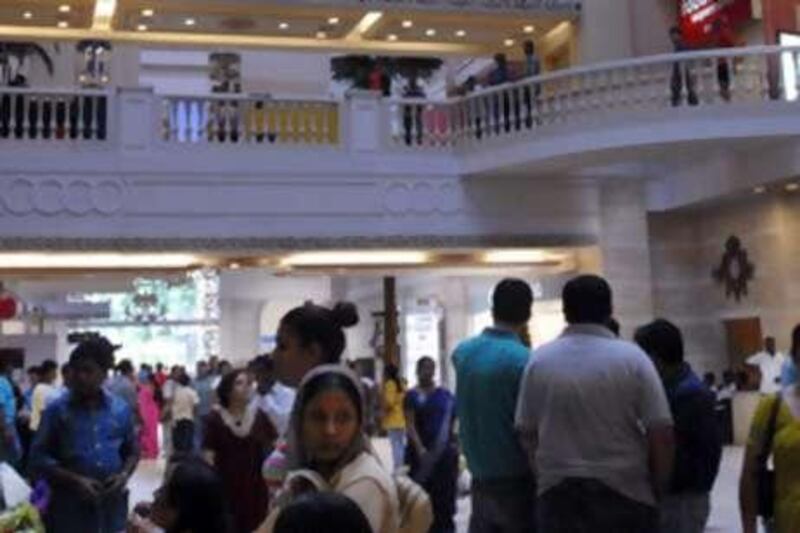Shopping in India is more than just a quick trip to the mall; it is a ritual. Whether for a wedding, a gift or to simply to keep up with the latest fashion, shopping, for an ever-increasing number of Indians, is becoming more a way of life than a luxury. However, until recently, the format for such excursions followed a very traditional structure. Consumers went to so-called "mom and pop" specialty shops to pick up an item or two, then it was off to another shop to look at other items. Even despite the crowded and heavily congested city streets, one-stop shopping was not a concept to catch on quickly in the world's second most populous country. That is, until now. From the urban streets of New Delhi and Mumbai to the suburbs of Punjab and Kerala, shopping in India has witnessed a revolution with the change in the consumer buying behavior and, along with it, a complete overhaul of the shopping format. The country's rapidly emerging middle class, as well as a changing lifestyle and favourable demographic patterns have paved the way for more Westernised shopping centres to penetrate the market. "India is also responding to what is happening in the world and the evolution of retail in general," said Shavak Srivastava, managing director of the Dubai-based Sq.Ft.Consulting UAE. "Most of the consumption in India is domestic and the demand domestically is very strong and growing." Already worth approximately US$350 billion (Dh1.28 trillion) a year in sales, India's retail industry is expected to grow by about 8 per cent per year, fueled by the growth of consumerism in urban areas, rising incomes, and a sharp rise in rural consumption. Only six to seven per cent of India's retail industry is "organised", with small businesses traditionally dominating the sector. However, the growing spending power by the country's emerging middle class has created a massive demand for broader, more diverse retail options. "The services industry is leading the development in India," said V Govan Raj, vice president of retail and marketing for Tanishq, India's largest jewellery retailer. "The average age for Indians is 25, it has one of the youngest economies in the world and we have good GDP growth." Industry estimates predict that as much as 30 per cent of the market will be dominated by malls, department stores and hypermarkets by 2010. The country's new organized retail segment alone is expected to be worth some US$200 billion by 2016. About 300 mall, 325 department store and 1,500 supermarket projects are currently under way across India, many of which cover more than one million sq ft. More than 100 million sq ft of gross leasable area (GLA) is due for completion by the end of the year, according to India's Associated Chambers of Commerce and Industry (Assocham). The country's success has manifested itself in sheer numbers. The World Bank predicts that India will be the world's second largest economy by the year 2050, placing it just behind China in terms of growth. Although an estimated one-third of India's population of 1.1 billion people lives below the poverty line, approximately 300 million are considered part of the country's middle and upper middle class. To put this into perspective, the current consumer base in India is equivalent to the total population of the United States. "Growth in emerging markets very attractive and bigger return on the investment," explained Phil McArthur, vice president for India for Ivanhoe Cambridge, a Canadian-based retail investment firm. "There is a ton of opportunities for retailers to get into property design and property developed malls." India's retail market have been dominated by many domestic giants, including Pantaloons Retail India, Shoppers Stop and Bata India, as well as the new international players wishing to penetrate the market. "From a retail perspective, the Indian market is at a very positive stage," explained Ashwin Puri, the chief executive of Property Zone India, a retail property consultancy. "The economy is growing and India is a positive story in general so it is a very attractive place for domestic and international investors looking to capitalise on the market growth." Once amongst the world's most closed off markets to international investors, a massive overhaul of India's foreign direct investment (FDI) policies beginning in 1998 has paved the way for the exponential growth being witnessed today. The Ministry of Industry has continued to expand the list of industries eligible for automatic approval of foreign investments and, in certain cases, raise the upper level of foreign ownership from 51 per cent to 74 per cent and further in certain cases to 100 percent. In fact, the World Investment Report 2008, released last week by the United Nations Conference on Trade and Development (UNCTAD), listed India as the second most-preferred global location for foreign investment in the world, behind China. As a result, many foreign developers - including several from the UAE-have sought to seize some of India's burgeoning opportunities. Emaar MGF, the property developer's Indian subsidiary, has the most established presence in the country with a number of projects in the works, including Central Plaza, a shopping centre in Mohali Hills in Pujab. According to a spokesperson with Emaar MGF, the company plans to contribute approximately 18 million square feet of retail space and 55 million sq ft of residential development across India by 2010. Last year, Dubai-based Al Fajer Properties announced a join venture to create a real estate fund in India to facilitate investments by small investors in Dubai. Majid al Futtaim Group is also studying opportunities in India's retail sector, although no deals have been finalised. Also Lulu Group, a subsidiary of Emke Group, recently commenced construction on a mixed-used development in the Indian city of Kochi, set to be one of the country's largest shopping centres. The Dh1.2billion multiplex will include a shopping mall, a five-star hotel and a unique tower geared exclusively for travel and tourism businesses when it opens in 2010. Hardly phased by the new wave of competition, some retailers believe it is the Indian-based companies who have a leg up. "I think it is all about the international players who should be worried about us," joked Kishore Biyani, the general manager of Pantaloon Retail, the flagship company of Future Group, a business group catering to Indian consumerism. However eager as they may be following an ease in foreign investment restrictions, investors have played the market cautiously in light of soaring property prices. Since the start of the property boom in 2003, property prices in India have spiked by as much as 400 per cent according to various industry estimates. "When you pay too much for land and you have commodity prices for steel, concrete and glass, you have to charge more for your real estate, but it doesn't work that way in shopping centres" said Mr McArthur. "Here, you've got all these retailers bleeding because the rent is too high." Property prices in medium-size cities have reportedly dropped by 15 per cent to 20 per cent in the last few weeks, even as it was said there has been no price adjustment in the large metropolises of New Delhi and Mumbai. Still, with massive amounts of capital to enter the market this year, many are fearful that the global economic downturn will eventually haunt investors in India. "Nobody knows whact of the global financial meltdown will be," said Mr McArthur. "For now, in India, the bubble has burst. Land values are sliding which is great for investors looking to develop in the country." vsalama@thenational.ae
India's shopping revolution
Shopping in India is more than just a quick trip to the mall; it is a ritual that has played out at family-owned businesses.

Editor's picks
More from the national




